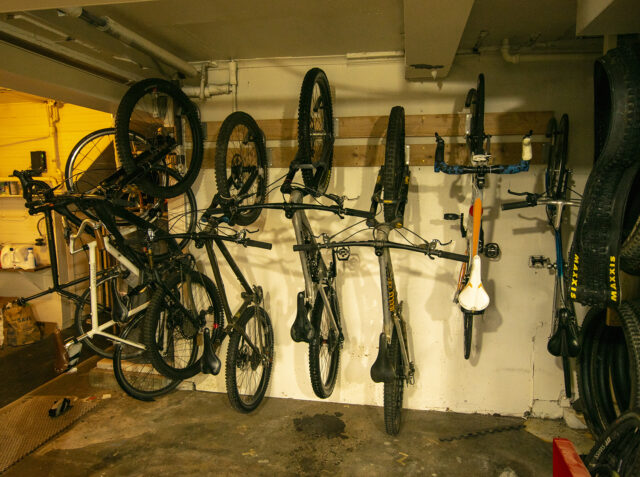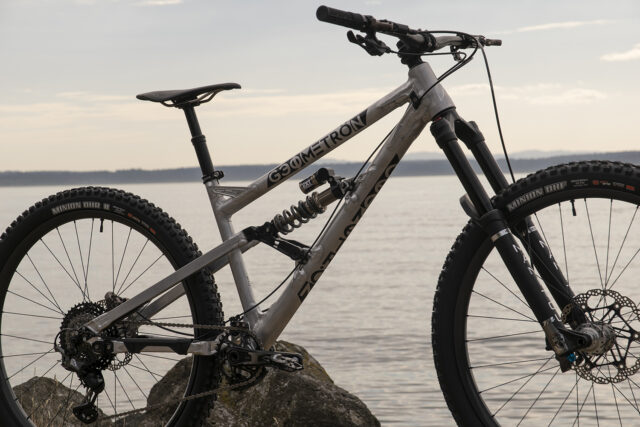
Why You Don’t Need a Big Quiver of Bikes
I spend a whole lot of time riding a ton of different bikes, and I’m constantly switching back and forth between at least a couple, if not five or six at any given time. I’m incredibly spoiled for choice when it comes to what to ride on a given day, and it’s been making me rethink what my dream quiver might look like — if storage and budget were no object. And, honestly, I don’t think it would have that many bikes in it.
Now, granted, what “not that many bikes” means is going to depend a bit on how many types of riding you really, actually do with any regularity. I get owning a road bike and a gravel bike and a mountain bike or two, and maybe a commuter / grocery getter if you really do all of those things often. Here, I’m really talking about mountain bikes, specifically.
The biggest problem with switching between bikes all the time is that it means I never get to feel 100% dialed in and at home on any given bike — including my own, personal rides. If I’m just out cruising around, that’s fine. But if you’re trying to push as hard as you can and really dial things up to 11, there’s a whole lot to be said for having the one bike that you’re locked in on and don’t need to reacclimate to each time you hop on it. Sure, any given bike is going to do some things better and some things worse, and you can maybe make a case for having a whole bunch of bikes to try to fully optimize performance for any given situation. But at some point that starts to ignore what is, if we’re being honest, the more limiting performance factor for most of us — the rider. I truly think that being fully comfortable and keyed in on a given bike is going to make a bigger difference in a lot of situations than trying to have a bike for every possible micro-niche.
My main personal ride these days is my Nicolai G1. It’s long and slack to a silly degree, and isn’t what I’d call a versatile bike. It’s also a truly outstanding bike for descending steep, technical trails and pedalling back to the top, and it turns out that’s also what I’m most into doing. It weighs almost 36 lb (actually, maybe more now — I’ve tweaked a few things since I weighed it, which definitely made it heavier). Yet I did a 7,500 vertical foot, 30-something-mile ride on it last weekend, and it was great. Would I have climbed faster on something lighter? Yes. Would I have had as much fun on the way back down? Nope. Am I happy with that tradeoff? You bet.

Some of the other benefits to a more bare-bones quiver are more straightforward. It’s obviously cheaper, for one, and another thing working at Blister has taught me is that more bikes means more maintenance, even if you’re spreading the same amount of riding across all of them as you’d log on a smaller number. You’d think an equal amount of total wear and tear would mean a similar amount of maintenance, but no. I can really enjoy bike maintenance when I’ve got the time and energy for it to feel relaxing, but more often than not these days, it just tends to feel like a chore.
I’ll also admit that I’m not very good at following my own advice. I “only” own two mountain bikes but obviously ride way more at any given time, and let’s just say that my personal ski quiver is bloated enough that I don’t care to admit the total count here. But ultimately, I think there’s a lot more value in having the right bike for you than having a whole bunch of options for specific situations. And as exciting as it sounds to have a monster quiver, I don’t think it’s everything it’s cracked up to be.
That’s not to say you should necessarily only have one mountain bike — again, what counts as a “big quiver” is going to depend a lot on how big a spectrum of riding you really do. But I do think that for most people, it’s not worth trying to have a bunch of overlapping options where you don’t have very clear delineation between which bike you’d grab for any given ride.
So What Do You Think?
Am I just suffering from grass-is-always-greener-itis, or am I on to something here? Let us know what you think in the comments.


Agree. I too have been surprised by how the amount, and cost, of ,main since on multiple bikes is higher than for one bike.
I would say, 2 mtb would cover most peoples needs pretty well, and for many of us (like me) 1 mtb is enough. I don’t hit Dh stuff hard enough to need anything more than a solid ~130-150mm trail bike, and although we have some smooth XC trails here, often enough there is a section of rough or steep trail in the ride where I’d be less happy on an XC bike, so the beefy trail bike is just fine for me.
Yup, a modern 150/140 bike is suited to just about everything. Sure it won’t be as effective as a specialized race bike in any one category but you’ll be having fun riding DH park laps as well as mellow XC trails. If I were to build a bike quiver a good hardtail and a longer travel (180 ish) bike would be nice additions, but I’d be totally fine without
The stuff you own, owns you. Somewhere one has to find an optimum between (outsourced) maintenance, ride time and skill development. I’ve noticed that some overlap between bikes can be beneficial for when one is in maintenance and conditions are favouring just that type of riding. With changing technology the optimal amount of gear one needs is changing. Periodically optimizing is probably the best one can do.
I’m almost getting philosophical to the point where I say: the amount of bikes one has says a lot on the amount of thought and training one has given.
Wasn’t it Andrew Skurka who once said on gear: we pack our fears.
The 8(?) bikes in the picture seems much for one person. One can be a social cyclist and lend friends a bike.
In my defense, that’s bikes for two people, and includes a couple of review bikes. :)
Pare down the bikes to genres and I think it makes sense if you shape shift:
Swiss Army Bikes: Santa Cruz Nomad (DH, Enduro, Downcountry) and Kona Rove (gravel/road/groceries/packing)
Inclement Weather: Kona SS Honzo (rainy days and dog rides), Charge Cooker drop bar fat bike (deep snow)
BMX Race: MCS Cruiser 24″
as a bike shop employee who has access to a lot of bikes to ride, I’ve found I’m super into the one bike at a time strategy. I really like just having one do it all bike. All of your setup time goes into dialing in one bike. all your upgrade budget goes to one bike. all of your riding is done on one bike so you get really used to that one bike and you get better at riding instead of constantly trying to switch riding styles for different bikes.
For me personally, I’ve found after trying many, many bikes, that despite really loving slack enduro 29ers, that the one bike I ride most often and enjoy most often is a 150/160 27.5 with a moderate HTA. It’s good for everything except the gnarliest stuff, in which case I just have to be off the back more. I wouldn’t take it to ride the gnarliest downhill tracks, but for everything else, it’s great.
I’m actually at a similar spot with skis. after years of having a quiver of 10+ pairs of skis, I settled on one pair for everything with Shifts. No, shifts aren’t the best bindings. No, my skis aren’t the best frontside skis or the best touring skis. But I literally never spend time thinking about which skis to ski or if I picked the right skis for today or wishing i had brought my other skis. I just ski. it’s awesome.
Amen! The best bike (or ski) is the one you have.
Depends on where you live. I have big mountain terrain in my backyard, so a long travel Enduro bike works great at home and for park/DH riding when traveling. If I lived somewhere with mellow terrain, I’d probably also have a short travel bike in addition to a big bike. Buy a bike that suits your home terrain and it will still be fun everywhere else.
Gotta agree. In his 2004 book “The Paradox of Choice”, Barry Schwartz explains the steps in the process of having so many choices that make us less satisfied.
You imagine you could have made a better choice.
You regret the decision, thinking it’s not perfect.
You imagine what you didn’t choose is better than what you did choose.
Your expectations escalate.
You have less satisfaction with the results even with good results.
It’s no longer possible for you to experience pleasant surprises.
Ive found my happy place with single speed DH bike for Bikepark days, ride it hard doesn’t need much work all season.
Epic Evo for my daily mountain bike, light super playful and plenty capable.
and my Pivot Point DJ, just another bike that doesn’t need much for upkeep but plenty fun for a quick session with friends.
New bikes are just so good at doing everything well that, n my opinion, it really cuts down the need for multiples. I’m on an Ibis ripmo (145mm 29″) that absolutely rips on pretty much everything.